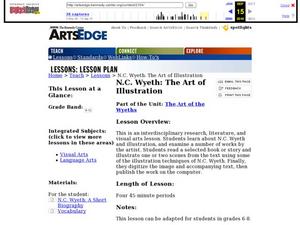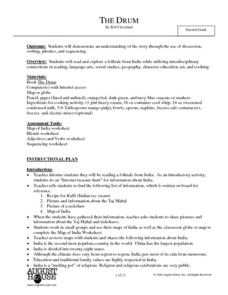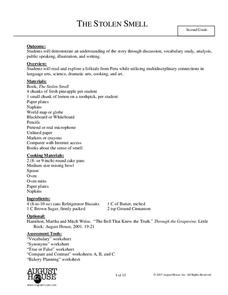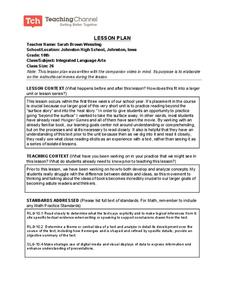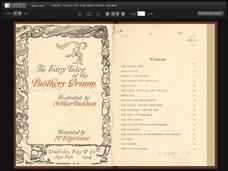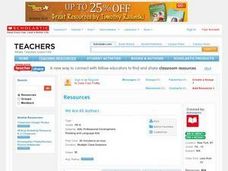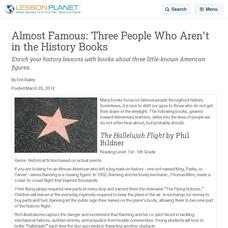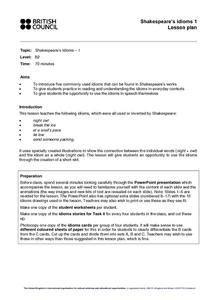Curated OER
Read and Draw- Silent E
In this long vowel O worksheet, students illustrate six words. Students draw a picture to go with words containing long vowel O with a silent E.
Curated OER
Clock Reading
In this reading clocks and telling time worksheet, 1st graders read the time given and draw the hands of the clock to illustrate that time.
Curated OER
Reading: Non-Fiction Format
In this reading non-fiction worksheet, students examine various texts and complete a graphic organizer filling in information about features, columns, paragraph length, font, pictures/illustrations, and purpose of text.
Curated OER
Art of Illustration: N.C. Wyeth and Literacy
High school artists observe and research the illustrations and techniques of N.C. Wyeth. They read (and reread) stories and illustrate the texts using methods inspired by Wyeth's practice. Includes detailed instructional plan and useful...
August House
The Drum
Take a journey to India with a read aloud of The Drum: A Folktale from India by Rob Cleveland. Make connections to the story's theme by building and practicing drums, role playing story characters, and practicing skills in phonics, math,...
Curated OER
The Stolen Smell
Second graders read the story The Stolen Smell and participate in many language arts based activity connected to the story. They participate in discussions, vocabulary work, analyzing the story, public speaking, illustrating pictures,...
Mark Twain Media
Understanding Informational Text Features
Everything you need to know about informational text features can be found in this resource. Recognizing these types of text features and how they are used in text allows readers to better understand information. Teachers can use this as...
Peter Bunzl
Cogheart and Moonlocket
Peter Bunzi takes readers to the Victorian era with two stories, Coghaert and Moonlocket. Accompany the literary time warp with a companion packet that offers a plethora of exercises. Learning opportunities include activities for before,...
Novelinks
The Little Prince: Blooms’ Taxonomy Questions
Question what you read with a lesson based on Bloom's Taxonomy. As kids read The Little Prince by Antoine de Saint-Exupéry, they formulate questions with cues from a graphic organizer, and answer them to work on critical thinking skills.
Teaching Channel
Storyboard Lesson Plan
Good books are accessible through a variety of literary lenses. To consider how the same story can be seen in different lights, groups develop a storyboard for a movie teaser that would focus on one of six concepts found in Suzanne...
Library of Congress
Fairy Tales of the Brothers Grimm
Include the eBook version of The Fairy Tales of the Brothers Grimm in your next fairy tale unit. Start with the table of contents to discover which tales to read first.
Reed Novel Studies
The Witches: Novel Study
Are witches like lions in sheep clothing? A boy and his grandmother in The Witches thinks so. They have even discovered the secret to recognizing these evil beings that disguise themselves as sweet ladies. Scholars use the resource to...
Curated OER
Language Arts: Scavenger Word Hunt
Participate in a scavenger hunt to find objects beginning with a particular letter sound and take digital photos of them with your scholars. Using software, they find word pictures beginning with particular letters and locate picture...
Art Educators of New Jersey
Exploring Eric Carle’s Painted Collage
Where does inspiration come from? Where do writers get their ideas? What about visual artists? A PowerPoint and a video introduce middle schoolers to children's author and illustrator Eric Carle and how he found inspiration in the work...
Curated OER
We Are All Authors: Create a Book
Every child is an author with this engaging reading activity. First the class reviews the various parts of a book such as the title, author, dedication, and author-biography. Then each individual will choose a story of their own to...
Houghton Mifflin Harcourt
Journeys: Challenge Activities (Theme 1)
This nine-page packet, the first in the series of support materials for the Houghton Mifflin Harcourt thematic units on journeys, contains enrichment activities for learners who have mastered the basic concepts of the lessons. Kids...
Centers for Ocean Sciences
Ocean and Great Lakes Literacy: Principle 7
Your mission, should you choose to accept it, is to take your class on an underwater adventure. The final installment in a seven-part series involving salt and freshwater bodies takes junior oceanographers below the surface in...
National Endowment for the Humanities
The World of Haiku
Students complete a study of Japanese culture through haiku. They read and interpret haiku poetry and write haiku of their own.
Curated OER
Almost Famous: Three People Who Aren't in the History Books
Enrich your history lessons with books about three little known figures: Thomas Banning, Annie Taylor, and Tony Sarg.
Houghton Mifflin Harcourt
Give It All You’ve Got!: Challenge Activities (Theme 2)
Explore ways to make research and writing more interesting. The first in a series of three challenge activities designed to accompany Theme 2: Give It All You've Got involve creating sports cards, designing cereal boxes, and using other...
Curated OER
Shizuko's Daughter: Concept of Definition Word Map
Help your class use critical thinking when it comes to unfamiliar words. With vocabulary from Kyoko Mori's Shizuko's Daughter, kids write the word in the center of a graphic organizer, and find its category, comparisons, examples, and...
Teacher Created Resources
The First Thanksgiving Book
Looking for a Thanksgiving week activity? Try this seven-page printable book documenting the story of the first Thanksgiving. Each page (1/2 sheet) has a short text along with a picture kids can color in.
British Council
Shakespeare’s Idioms
Lie low. Break the ice. He's a night owl. Idioms, in this case idioms created by Shakespeare, are the focus of resource that includes a PowerPoint presentation, an activity, and a brief lesson, all intended to give kids a chance to...
Maryland Department of Education
The Concept of Identity Lesson 4: The Psychological Approach
Readers apply Sigmund Freud's theories of the unconscious mind and the psychological approach to literary criticism to analyze and evaluate the relationship between two characters in A Separate Peace.





